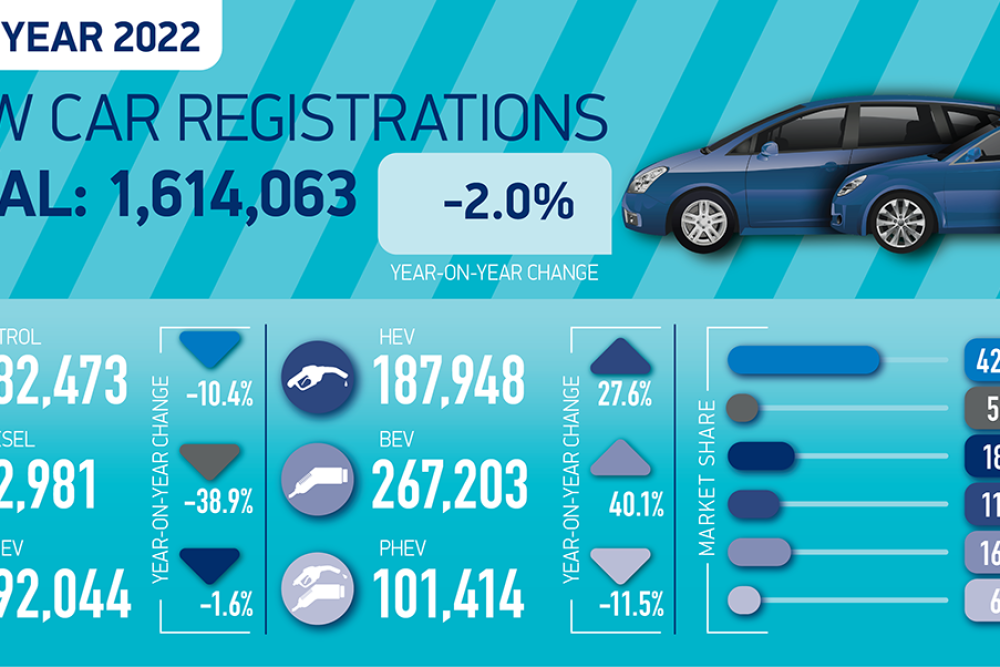CONSTRAINED supply saw many manufacturers prioritise deliveries of zero emission-capable models in December although the month saw battery electric vehicles claim their largest ever monthly market share, of 32.9%.
For 2022 as a whole they comprised 16.6% of registrations, surpassing diesel for the first time to become the second most popular powertrain after petrol.
Meanwhile, plug-in hybrids (PHEVs) saw their annual share decline to 6.3%, meaning that combined, all plug-in vehicles accounted for 22.9% of new registrations in 2022 – a record high, although a smaller increase in overall market share than recorded in previous years.
Hybrid electric vehicles (HEVs) also enjoyed growth, rising to an 11.6% market share for the year. As a result, average new car CO2 fell 6.9% to 111.4g/km, yet again the lowest in history.
While private buyers accounted for more than half of all registrations, fleets and business buyers were responsible for the lion’s share of BEVs, accounting for two thirds (66.7%) of all BEV registrations and 74.7% of the volume gain in 2022. Delivering the scale and speed of market transition required to meet climate change targets will require action to enthuse more private buyers to go electric.
The Society of Motor Manufacturers and Traders said that while the industry recognises the need for fair vehicle taxation, plans to introduce VED on BEVs from 2025 with the same ‘premium’ threshold as internal combustion-engine cars will disproportionately penalise those moving to electric. Higher production costs mean more than half of all BEV registrations this year would have incurred the ‘premium’ VED if it had been in place, a move which risks discouraging wider adoption
Chargepoint provision also remains a barrier to EV uptake. The government’s EV Infrastructure Strategy forecast that the UK would require between 300,000 and 720,000 chargepoints by 2030. Meeting just the lower number would still require more than 100 new chargers to be installed every single day. The current rate is around 23 per day.
John Wilmot, Chief Executive at car leasing comparison website LeaseLoco said: “It’s time we saw progress in the rollout of chargepoints not rhetoric. Every month it’s the same message about chargepoint provision being a significant barrier to entry to people switching to zero emissions motoring, but very little seems to change.
“Even if you take the the lower estimate of the government’s EV infrastructure strategy forecast, that we need 300,000 chargepoints by 2030, almost two thirds of local authorities aren’t installing charging points fast enough to even get close to this target.
“While EVs grabbing second spot in market share makes good headlines, the reality is that growth in electric vehicle ownership in the UK is actually falling according to the latest Department of Transport electric vehicle registrations data.
“Between Q2 2022 and Q3 2022, battery electric vehicle registrations increased just 9.8%, compared to 11.6% between Q1 2022 and Q2 2022, and 15.5% between Q4 2021 and Q1 2022.
“With the government’s focus likely to be elsewhere in the coming months, as the country grapples with high inflation and the cost of living crisis, it’s hard to believe that EV charger provision is going to be at the top of MPs’ intrays.”
Manufacturers face a Zero Emission Vehicle Mandate from 2024 (the details of which have still not been published). As a result, accelerated investment in charging infrastructure is needed if consumers are to be confident they can make the switch and brands are to have a chance of securing sufficient supply to support UK market growth and not lose out to other markets which are investing more rapidly.
Last year, Britain reclaimed its position as Europe’s second largest new car market by volume, both overall and, specifically for plug-in cars. However, as of the end of Q3 2022, it was 13th overall by plug-in market share, behind markets including Norway (78.3%), the Netherlands (28.7%) and Germany (23.5%).
Kim Royds, EV Director at British Gas, said: “The uptick of electric vehicle registrations was a bright light in a challenging year for the new car market in 2022. Record numbers of EVs entering the roads is proof that drivers are continuing to unlock the benefits of making the switch to electric as we accelerate the UK’s journey towards net zero.
“To ensure that growth in the EV market is sustainable for the long term, we must look seriously at the country’s charging network and its capacity to keep up with increasing demand. Ensuring everyone has access to suitable charging infrastructure is a critical milestone in the UK’s electrification journey and expanding both at-home and public charging infrastructure must remain a top priority.”
According to the latest EY research and analysis, EV sales in the US, China and Europe will outstrip all other engines three years sooner than previously expected.
The figures come from the EY Mobility Lens Forecaster, an artificial intelligence (AI) powered forecasting tool that provides an outlook for light vehicle registrations through to 2050.
The latest predictions show that by 2027 EV sales in Europe will surpass those of other powertrains, a trend that will be repeated in both China and the US by 2032. For Europe and China this is one year faster than previously expected and for the US four years faster, driven by continued investments in electrification.
Randall Miller, EY Global Advanced Manufacturing & Mobility Leader, said: “Despite a series of finance and energy related headwinds in the last twelve months, the EV revolution continues to gain momentum and the point at which we think EVs will come to dominate the marketplace has actually moved forward.
“In Europe, car sales in general are down and we would expect the move over to EVs to potentially struggle if the energy crisis persists. This would require more government assistance to maintain the current pace.
“In China, while we expect EV to dominate sales by 2032, we also see hybrids sustaining their market share all the way up to 2050. In the US we see large population states leading the way, so there remains cause for optimism in meeting the 2030 target for 50% of sales being EVs. Despite this the US will need to deal with supply chain issues and recessionary headwinds focusing on charging infrastructure and in-country battery development to really push on with EVs.”
Rising consumer demand backed by government policies and incentives, along with aggressive electrification targets by OEMs have accelerated the transition to EV adoption in all the three key regions. Benefits of a carbon-neutral mobility ecosystem are now being realized at a larger scale which has led to substantial investments in all the three regions towards setting up EV infrastructure and transitioning from fossil-led mobility ecosystem to an electric one.








